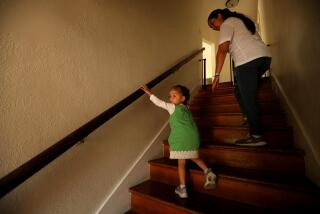‘Critical housing needs’ growing, policy group finds
- Share via
The number of low- to moderate-income working families spending more than half their earnings on housing climbed more than 67% from 1997 to 2001, the result of stagnant wages and rising housing costs, a new study shows.
The report, released last week by the Center for Housing Policy, revealed that those with “critical housing needs” reside not only in urban areas but also in the suburbs and outside major metropolitan areas. And those affected are not only the poor; many middle-income Americans also are unable to afford decent housing.
In 1997, about 3 million low- to moderate-income working families had “critical housing needs,” meaning they used more than half their incomes on housing. By 2001, that number rose to 4.8 million households, according to the study.
While some of these households were in the nation’s most expensive housing markets, such as San Francisco, others had stagnant salaries that could not keep up with the cost of owning or renting a home, said Ann Schnare, president of the Center for Housing Policy.
More to Read
Sign up for Essential California
The most important California stories and recommendations in your inbox every morning.
You may occasionally receive promotional content from the Los Angeles Times.






